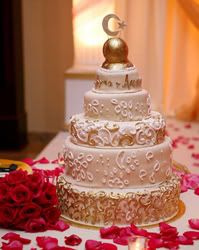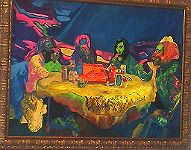 |
Here is more evidence that Muslims have no intention of really integrating into Western culture.
The recent wedding of a young Muslim South Asian newscaster from New Jersey was depicted as "a fusion" of cultures. In reality, there is not much "fusion about it.
I know this isn't an Ontario story, but the New Jersey story was the one I could find with the most detail about young married, or soon-to-be married Muslim couples.
Still, regarding Ontario, the writer and creator of Little Mosque on the Prairie, Zarqa Nawaz, has talked about her husband and family life. She recounts her husband "supporting" her career as a filmmaker by relocating from Saskatchewan to Toronto, as though he made special sacrifices. But, her husband is a doctor, and unlikely not to find work anywhere, given the shortages. So, moving to Toronto from Saskatchewan to follow his new filmmaker wife's career wasn't such a risky move. In the end, as it happens, they had to return to Saskatchewan because...it didn't suit the husband's career plans. Doctors from out of Ontario have to wait three years before gaining residency. So much for the "feminist" woman full of career moves with the supportive modern Muslim husband. Of course, her TV series is also a heavily subsidized CBC affair, where her real entrepreneurship and creativity is not important. I'm sure it is her "female and Muslim" attributes that gave her the show.
Back to New Jersey.
Syma and Aamer are American-born well-established Muslims. Syma is both Pakistani and Indian. Her now-husband Aamer is Indian. Syma has a semi-glamorous life as a fashion model and a newscaster at News 12, and Aamer is an attorney. They met through a chat line, and dated for a year before they became engaged. Such a long dating period is frowned upon, but this outgoing, rule-breaking couple did it anyway.
Other rules they broke?
- Syma wore an off-white wedding dress (actually it looks more like a sari to me) instead of the traditional red one.
- Syma decided to have the henna-painting ceremony - the mehndi - before the wedding ceremony - the nikah. (Unfortunately, we are having to learn new vocabulary as well)
- There were bridesmaids whose saris matched the wedding sari and other decor
- Although the couple had a traditional nikah (yes that would be wedding) ceremony, they gave each other rings, as per Western traditions
- The bride and groom also followed other Western wedding traditions such walking down the "aisle", cutting of the cake, throwing of the bouquet (but not the garter!) and having the first dance as a married couple (couples apparently don't dance in Muslim wedding ceremonies).
But, more detail shows this is just really fluff.
They got married under strict Muslim tenets, reciting words from the Koran. And Syma's mother had the last say in almost all the big decisions, including having the wedding venue in a formal, large hall with hundreds of guests unlike the few dozen Syma was planning. Large communities are ways in which such groups keep their bonds strong. One small detail, which sounds quaint: the wedding cake had a mosque dome, a crescent and a star as the cake topper.
When push comes to shove, the "fusion" parts of Muslim weddings, and married couples, is in the artificial and unimportant ones - well, some might relinquish a little more. But, the essentials of the weddings are all there, and no real tradition is broken.
Even the Western rites are submerged and integrated into the Muslim/non-Western ones, and not the other way round.





